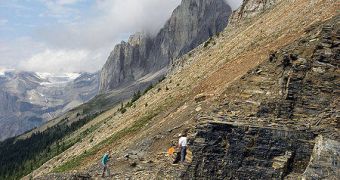The Burgess Shale Formation is one of the most well-preserved archaeological sites in the world. It features a wealth of fossils, from a world that disappeared some 500 million years ago, when the area of the Canadian Rocky Mountains where it's located was a seabed teeming with life. Despite thousands of millennia of seismic activity, volcanism and tectonic-plate movement, the fossil layer has been so well preserved, that most of its fossils still have their soft tissues, such as skin and even eye balls, intact.
This month marks the Burgess Shale's 100th anniversary since it was discovered by Smithsonian Institution paleontologist Charles Walcott in late August, 1909. The site is located close to the city of Field, in British Columbia, LiveScience reports.
It is one of the extremely few places thus far discovered on the entire planet that still preserve the complete fossils of animals that died there in the past, and not just traces of hard shells, bones and teeth. The role that this depository played in our understanding of the past is summed up nicely in late paleontologist Stephen Jay Gould's book, “Wonderful Life: The Burgess Shale and the Nature of History.”
In addition to the fact that the formation's “inhabitants” are well preserved, and sometimes even full fossils are found, the Burgess Shale also continuously reveals a wealth of fossils, belonging to a very high number of species. They all lived during the Cambrian Explosion, a period stretching from roughly 542 to about 488 million years ago. A conference on this portion of prehistory was held earlier this month by paleontologists meeting in Banff, Alberta, Canada.
According to a conference organizer, the goal of the meeting was “to celebrate the one hundredth anniversary of the discovering of the Burgess Shale by Charles Walcott and to bring delegates from all across the world to talk about Cambrian fossils.” The organizer, Jean-Bernard Caron, is an associate curator at the Royal Ontario Museum, in Toronto.
“We have now a more complete picture of early animal evolution and the relation of the fossils of the Burgess Shale to it than we had twenty years ago. [This] highlights the fact that the Burgess Shale is still at the forefront of science,” paleontologist Alex Page, who holds an appointment at the University of Cambridge, in England, concludes.

 14 DAY TRIAL //
14 DAY TRIAL //